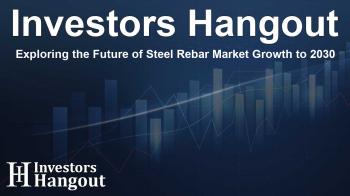Exploring the Future of Steel Rebar Market Growth to 2030

Steel Rebar Market Projected to Reach USD 268.4 Billion
The global steel rebar market is on a rapid growth trajectory, projected to reach USD 268.4 billion by the end of the decade. This increase stems from a Compound Annual Growth Rate (CAGR) of 4.0%, reflecting a strong demand for these critical construction materials.
Steel rebars, which are essential for reinforcing concrete, enhance the tensile strength of structures. These high-strength rods are vital in a variety of construction projects, including skyscrapers, bridges, and highways, thereby ensuring safety and durability over time. Most commonly manufactured from carbon steel, rebars come in deformed types with surface textures for improved grip as well as plain varieties suited for specific applications.
Dominant Market Drivers in Infrastructure Sector
Among various segments, the infrastructure sector has emerged as the primary driver, accounting for the largest market share. Investments in infrastructure enhancements and new projects across the globe, especially in developing countries, are fueling demand. Governments prioritizing infrastructure upgrades are focusing on building transit systems, airports, and other public facilities, making steel rebars an indispensable component in these projects.
Rapid urbanization is notably impacting regions like Asia Pacific and the Middle East, where extensive public works projects are underway. As cities expand and modernize, the need for robust materials that can withstand environmental stresses is paramount. Notably, both North America and Europe are also investing in renovating aging infrastructures, promoting a consistent demand for high-quality steel rebars.
Emerging Trends in Coating Types and Material Use
Turning to the coating type, plain carbon steel rebars are forecasted to exhibit the highest growth rate through 2030. The appeal of this segment lies in its cost-effectiveness and ease of availability, making it the material of choice for general construction where additional protective measures are not required. The affordability of plain carbon steel is particularly advantageous in developing regions, where rapid urban growth leads to increased construction activity.
While plain carbon steel rebars dominate, there are also protective coatings like epoxy and galvanized options which provide enhanced corrosion resistance but are often reserved for specialized applications due to their elevated costs. Ongoing advancements in construction methodologies and concrete technology are enabling a safer and longer-lasting usage of these materials.
Asia Pacific Emerges as Market Leader
In 2024, the Asia Pacific region held the largest share in the steel rebar market. The escalating demand is fueled by high levels of urbanization and extensive governmental investments in infrastructure. Major contributors such as China and India are advancing construction on a massive scale—China through its urban renewal initiatives, and India via ambitious projects aimed at enhancing urban living conditions, including Smart Cities and affordable housing initiatives.
The resurgence of these markets highlights the potential for consistent growth in rebar consumption in the upcoming years. As foreign investments rise, the regulatory landscape becomes more favorable, and local production capabilities expand, Asia Pacific is firmly positioned as the leading influence in the global steel rebar market.
Key Players Shaping the Steel Rebar Market
The competitive landscape of the steel rebar market features significant players including Nippon Steel Corporation, ArcelorMittal, and Nucor Corporation, among others. These companies are employing strategies such as mergers, acquisitions, and innovative product development to strengthen their market presence. Their efforts continually contribute to improving technological advancements and optimizing production processes in response to evolving market demands.
Frequently Asked Questions
What is the projected growth of the steel rebar market?
The steel rebar market is projected to reach USD 268.4 billion by 2030, growing at a CAGR of 4.0%.
Why is the infrastructure segment crucial in the steel rebar market?
The infrastructure segment is crucial due to ongoing investments in construction and upgrades, which consistently drive demand for steel rebars.
What are the types of steel rebars available?
The main types of steel rebars include deformed bars with surface ribs and plain bars for simpler applications.
Which region is leading the steel rebar market?
The Asia Pacific region is currently the leading market for steel rebars due to extensive urbanization and government spending on infrastructure projects.
What are the trends in coating types for steel rebars?
Plain carbon steel rebars are trending upward due to their cost efficiency, while epoxy and galvanized options are preferred for specialized corrosion-resistant applications.
About The Author
Contact Caleb Price privately here. Or send an email with ATTN: Caleb Price as the subject to contact@investorshangout.com.
About Investors Hangout
Investors Hangout is a leading online stock forum for financial discussion and learning, offering a wide range of free tools and resources. It draws in traders of all levels, who exchange market knowledge, investigate trading tactics, and keep an eye on industry developments in real time. Featuring financial articles, stock message boards, quotes, charts, company profiles, and live news updates. Through cooperative learning and a wealth of informational resources, it helps users from novices creating their first portfolios to experts honing their techniques. Join Investors Hangout today: https://investorshangout.com/
The content of this article is based on factual, publicly available information and does not represent legal, financial, or investment advice. Investors Hangout does not offer financial advice, and the author is not a licensed financial advisor. Consult a qualified advisor before making any financial or investment decisions based on this article. This article should not be considered advice to purchase, sell, or hold any securities or other investments. If any of the material provided here is inaccurate, please contact us for corrections.

